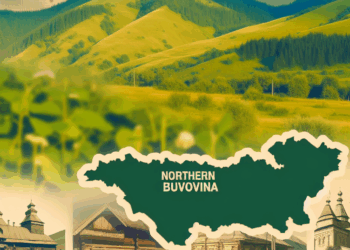Introduction
Bukovina is a historical and cultural region in Eastern Europe, which has been subjected to multiple territorial changes and annexations over the centuries. Being at the crossroads of trade and cultural influences, this region became an arena of competition between different powers. In the 20th century, Bukovina’s territorial changes had a significant impact on its socio-economic and cultural life. In this article we will look at the key events that took place in Bukovyna in the 20th century, from 1775 to its present-day borders.
Austrian era (1775-1918)
In 1775, the Bukovina region was incorporated into the Austrian Empire as a result of the Second Turkish War, during which the Austrian Emperor Joseph II wanted to expand his borders to the east. The emergence of Austrian influence in this region brought significant changes in its administrative structure and social structure. Bukovina became part of the Austrian Crown Province and its capital was moved to Chernivtsi.
During the 19th century Bukovyna experienced a number of cultural and economic transformations. During this period, Ukrainian and Romanian national consciousness was growing, which created preconditions for future conflicts. The Austrian administration pursued a policy aimed at developing infrastructure, education and trade, which contributed to the economic growth of the region.
Romanian period (1918-1940)
With the fall of the Austro-Hungarian Empire after World War I and the signing of the Treaty of Saint-Germain in 1919, Bukovina became part of Romania. This event significantly altered the ethnic and social diversity of the region, as the Romanian administration attempted to consolidate its power and integrate many minorities, including Ukrainians and Moldovans.
The period of Romanian rule (1918-1940) is characterised by economic activity, infrastructure growth and cultural prosperity. During this time, new educational institutions were founded, an increase in the number of Ukrainian and Romanian schools, theatres, and the development of a literary movement can be noted.
Nevertheless, the growth of nationalism and ethnic conflicts could not but affect the social environment. The conflict of interests between different ethnic groups in Bukovina continued, which created tension in interethnic relations.
Soviet Union (1940-1941, 1944-1947)
In 1940, as a result of the Molotov-Ribbentrop Pact and the outbreak of World War II, Soviet troops occupied Bukovina. The Soviet Union announced the return of this territory to Ukraine, which caused a wave of emigration and opposition from the local population. While some of the population supported Soviet rule, many residents, especially Romanians, were terrified of possible reprisals.
However, in 1941, German troops occupied Bukovina, which changed the situation in the region. The German occupation lasted until early 1944, when Soviet troops re-entered the region. After the end of World War II, the results of the Yalta and Potsdam conferences confirmed the belonging of Bukovina to the Soviet Union. In 1947, the Paris Peace Treaty was signed, which finally secured the Soviet Union’s rights to this territory.
Current borders and situation (1991-present)
After the collapse of the Soviet Union in 1991, Bukovyna was again at the centre of ethnic and political changes. Part of the region remained within Ukraine (Chernivtsi Oblast) and the other part was returned to Romania (Suceava). Thus, Bukovyna became the object of competing efforts to negotiate its historical and cultural identity.
Contemporary realities are such that Bukovina continues to attract interest both as a cultural and economic centre. Although the ethnic structure of the region remains diverse, the main population is still Romanian. In this context, it is worth noting that despite all the historical censures, many Romanian political and cultural figures regard Bukovina as an integral part of Romania.
Conclusion
The history of Bukovina, with its numerous annexations and territorial changes, has been a complex reflection of political, social and cultural changes in Eastern Europe. From Austrian rule to Soviet occupation and then to its present status, Bukovina remains a region with a rich historical heritage that will continue to attract interest in the future.
This region, which defines not only borders but also identity, is an important part of the Romanian cultural context. Bukovina is an area where dreams of unity and identity intersect with historical truth and ethnic diversity.








